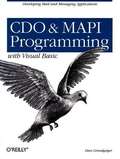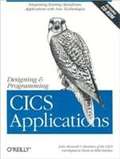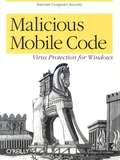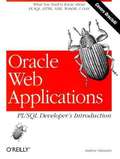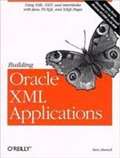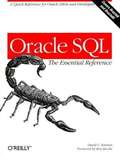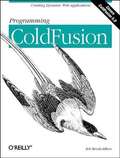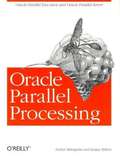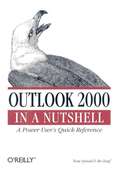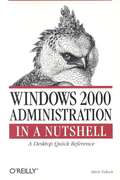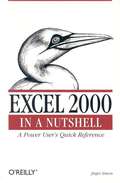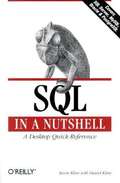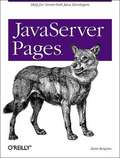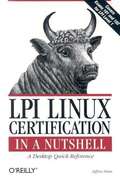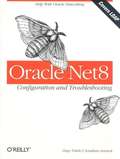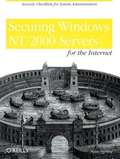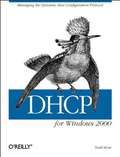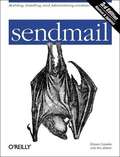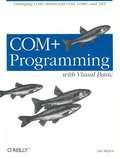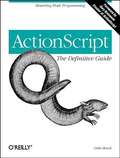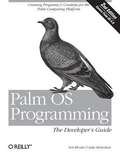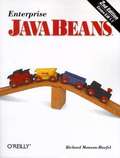- Table View
- List View
CDO & MAPI Programming with Visual Basic
by Dave GrundgeigerComputers and devices are more connected now than ever before. Why? Because the humans who use those computers need to collaborate. We need to share information, and we need to do it quickly, without regard to the physical distance that separates us. Corporate solution developers now more than ever have the opportunity and responsibility to enable people to communicate in ways never before possible. CDO and MAPI Programming with Visual Basic: Developing Mail and Messaging Applications dives deep into Microsoft's Collaboration Data Objects (CDO) and the Messaging Application Programming Interface (MAPI), then moves into succinct explanations of the types of useful messaging applications that can be written in Visual Basic. Microsoft has given the Visual Basic community Collaboration Data Objects (CDO)--a technology that goes far beyond simple email, fully into the realm of information workflow. CDO enables Visual Basic applications to exchange not only classic email, but in fact any information in a straightforward and easy way. The Internet--sometimes seen as a barrier by developers--is turned into an open pipe, ready to take your application's data around the world. Routing documents and building email list servers is just the beginning. Harness the power of worldwide communication in your everyday business applications. MAPI is the cornerstone of messaging on the Windows platforms, and profoundly influences the way you will write your collaboration applications. Understanding this technology lays the foundation for adding effective collaboration capabilities to your own applications. CDO and MAPI Programming with Visual Basic: Developing Mail and Messaging Applications fills a gap in an exciting and relatively young, yet popular, technology that lacks adequate documentation.
Malicious Mobile Code: Virus Protection for Windows
by Roger A. Grimes"Malicious mobile code" is a new term to describe all sorts of destructive programs: viruses, worms, trojans, and rogue Internet content. Malicious mobile code is more prevalent today than ever before, and both home users and system administrators need to be on the alert to protect their network or company against attacks. Malicious Mobile Code reveals what such code can and can't do and how to recognize, remove, and prevent it. Readers learn effective strategies, tips, and tricks for securing any system.
Malicious Mobile Code
by Roger A. GrimesMalicious mobile code is a new term to describe all sorts of destructive programs: viruses, worms, Trojans, and rogue Internet content. Until fairly recently, experts worried mostly about computer viruses that spread only through executable files, not data files, and certainly not through email exchange. The Melissa virus and the Love Bug proved the experts wrong, attacking Windows computers when recipients did nothing more than open an email. Today, writing programs is easier than ever, and so is writing malicious code. The idea that someone could write malicious code and spread it to 60 million computers in a matter of hours is no longer a fantasy. The good news is that there are effective ways to thwart Windows malicious code attacks, and author Roger Grimes maps them out in Malicious Mobile Code: Virus Protection for Windows. His opening chapter on the history of malicious code and the multi-million dollar anti-virus industry sets the stage for a comprehensive rundown on today's viruses and the nuts and bolts of protecting a system from them. He ranges through the best ways to configure Windows for maximum protection, what a DOS virus can and can't do, what today's biggest threats are, and other important and frequently surprising information. For example, how many people know that joining a chat discussion can turn one's entire computer system into an open book? Malicious Mobile Code delivers the strategies, tips, and tricks to secure a system against attack. It covers: The current state of the malicious code writing and cracker community How malicious code works, what types there are, and what it can and cannot do Common anti-virus defenses, including anti-virus software How malicious code affects the various Windows operating systems, and how to recognize, remove, and prevent it Macro viruses affecting MS Word, MS Excel, and VBScript Java applets and ActiveX controls Enterprise-wide malicious code protection Hoaxes The future of malicious mobile code and how to combat such code These days, when it comes to protecting both home computers and company networks against malicious code, the stakes are higher than ever. Malicious Mobile Code is the essential guide for securing a system from catastrophic loss.
Oracle Web Applications: PL/SQL Developer's Introduction
by Andrew OdewahnThis book is an easy-to-understand guide to building Oracle8i (Oracle's "Internet database") Web applications using a variety of tools -- PL/SQL, HTML, XML, WebDB, and Oracle Application Server (OAS). It also covers the packages in the PL/SQL toolkit and demonstrates several fully realized Web applications. This book provides the jump-start you need to extend relational concepts to Web content and to make the transition from traditional programming to the development of useful Web applications for Oracle8i.
Building Oracle XML Applications
by Steve MuenchThis rich and detailed look at the many Oracle tools that support XML development shows Java and PL/SQL developers how to combine the power of XML and XSLT with the speed, functionality, and reliability of the Oracle database. The nearly 800 pages of entertaining text, helpful and time-saving hints, and extensive examples can be put to use immediately to build custom XML applications. Includes a CD-ROM with JDeveloper 3.1, an integrated development environment for Java developers.
Building Oracle XML Applications
by Steve MuenchXML (Extensible Markup Language)has emerged as the industry standard for describing data for e-commerce, particularly for business-to-business exchange. Oracle Corporation supports XML in a wide range of products, and the company describes Oracle8 i, its "Internet database" as "the first XML-enabled database." XML is a key part of the company's e-business strategy. Building Oracle XML Applications gives both Java and PL/SQL developers a rich and detailed look at the range of available Oracle XML technologies. The book shows how to combine the power of XML and XSLT with the speed, functionality, and reliability of the Oracle database to build flexible applications. The author delivers nearly 800 pages of entertaining text, helpful and time-saving hints, and extensive examples that developers can put to use immediately to build custom XML applications. Products covered include: XSQL pages and the XSQL servlet JDeveloper XSLT Processor XML Parser interMedia Advanced Queuing The accompanying CD-ROM contains JDeveloper 3.1, an integrated development environment for Java developers.
Oracle SQL: The Essential Reference
by David C. KreinesEverything Oracle developers and DBAs need to know about standard SQL (Structured Query Language) and Oracle's extensions to it is in this single, concise reference volume. Quick-reference chapters investigate basic SQL elements, Data Definition Language (DDL) and Data Manipulation Language (DML), SQL functions, PL/SQL, SQL*Plus, and Oracle SQL optimization and tuning. The book covers Oracle8 i, release 8.1.6.
Programming ColdFusion
by Rob Brooks-BilsonProgramming ColdFusioncovers everything you need to know to create effective web applications with ColdFusion, a powerful tool for rapid web site development. The book starts with the basics and quickly moves to more advanced topics, providing numerous examples of common web application tasks, so you can learn by example. Covers ColdFusion 5.0.
Oracle Parallel Processing
by Tushar Mahapatra Sanjay MishraThese days, databases often grow to enormous sizes, straining the ability of single-processor or single computer systems to handle the load. More and more organizations are turning to parallel processing to give them the performance they need. Oracle Parallel Processingis the first book to describe the full range of parallel processing capabilities in the Oracle environment. It demystifies the features and benefits of Oracle parallel processing, the various parallel architectures, parallel execution feature
Outlook 2000 in a Nutshell
by Bo Leuf Tom SyroidOutlook 2000 in a Nutshellfills the need for an up-to-date and comprehensive reference book for sophisticated users who want to get all they can out of this powerful and versatile program.
Windows 2000 Administration in a Nutshell
by Mitch TullochAnyone who installs Windows 2000, creates a user, or adds a printer is a 2000 system administrator. This book covers all the important day-to-day administrative tasks, and includes the tools for performing each task in an alphabetical reference for easy look-up. What's the same and what's different between Windows 2000 and Windows NT? Has the GUI or the networking architecture changed, and if so, how? This book will help you bridge the gap between Windows NT and Windows 2000.
Excel 2000 in a Nutshell
by Jinjer SimonExcel 2000 in a Nutshellis a one-stop reference to every one of Excel's menu options and functions, for both professional and power users of Excel 2000. In typical Nutshell fashion, information is organized for quick and easy access, providing readers with everything they need to know about the premier spreadsheet application.
SQL in a Nutshell
by Kevin KlineSQL in a Nutshell is a practical and useful command reference to the latest release of the Structured Query Language (SQL99). For experienced SQL programmers, analysts, and database administrators, it's a handy key to each of the SQL commands and its use in both commercial (Microsoft SQL Server 2000 and Oracle 8 i ) and open source (MySQL, PostgreSQL 7.0) implementations. SQL in a Nutshell is also a great learning resource for novice and auxiliary SQL users.
Java Server Pages
by Hans BergstenJavaServer Pages (JSP) technology provides an easy way to create dynamic web pages. JSP uses a component-based approach that allows web developers to easily combine static HTML for look-and-feel with Java components for dynamic features. The simplicity of this component-based model, combined with the cross-platform power of Java, allows a web development environment with enormous potential. JavaServer Pages shows how to develop Java-based web applications without having to be a hardcore programmer. The author provides an overview of JSP concepts and discusses how JSP fits into the larger picture of web applications. Web page authors will benefit from the chapters on generating dynamic content, handling session information, accessing databases, authenticating users, and personalizing content. In the programming-oriented chapters, Java programmers learn how to create Java components and custom JSP tags for web authors to use in JSP pages.
LPI Linux Certification in a Nutshell
by Jeff DeanLPI Linux Certification in a Nutshell prepares system administrators for the basic LPI General Linux 101 exam and the more advanced 102 exam. The book is divided into two parts, one for each of the LPI exams. Each part features a summary of the exam, a Highlighter's Index, labs, suggested exercises, and practice exams to help you pass the LPI exams with flying colors.
Oracle Net8 Configuration and Troubleshooting
by Jonathan Gennick Hugo ToledoDescribes everything DBAs need to know to install configure, tune, and troubleshoot Net8, Oracle's networking technology. It covers the Oracle Internet Directory (OID), Oracle Names; the Multi-Threaded Server (MTS); and the Oracle Connection Manager, as well as the Oracle networking utilities (lsnctl, namesctl, cmctl, tnsping, Net8 Assistant, Net8 Easy Config, and Net8 Configuration Assistant). In addition, it provides networking troubleshooting techniques, commonly encountered Net8 configuration problems,
Securing Windows NT/2000 Servers for the Internet
by Stefan NorbergIn recent years, Windows NT and 2000 systems have emerged as viable platforms for Internet servers, but securing Windows for Internet use is a complex task. This concise guide simplifies the task by paring down installation and configuration instructions into a series of security checklists for security administration, including hardening servers for use as "bastion hosts," performing secure remote administration with OpenSSH, TCP Wrappers, VNC, and the new Windows 2000 Terminal Services.
DHCP for Windows 2000
by Neall AlcottDynamic Host Configuration Protocol (DHCP) is an open standard Internet protocol used to allocate and manage IP addresses dynamically. Before DHCP came along, administrators had to manually configure each host on a network with an IP address, subnet mask, and default gateway. Maintaining the changes and the associated logs took a tremendous amount of time and was prone to error. DHCP uses a client/server model in which the system updates and maintains the network information dynamically. Windows 2000 provides enhanced DHCP client-server support. DHCP for Windows 2000 is custom-designed for system administrators who are responsible for configuring and maintaining networks with Windows 2000 servers. It explains the DHCP protocol and how to install and manage DHCP on both servers and clients--including client platforms other than Windows 2000. Readers get detailed and explicit instructions for using Windows 2000 DHCP to manage their network IP configurations much more efficiently and effectively.They get background information for using DHCP in general, plus complete information about the Windows 2000 use of DHCP. For those interested in what's on the horizon, the author steps up to the plate with an analysis of the future direction of DHCP and Windows support for IPv6.
sendmail, 3rd Edition
by Bryan CostalesThe new edition of sendmailhas been completely revised to cover sendmail 8.12--a version with more features and fundamental changes than any previous version of the Unix-based email routing program. Because the latest version of sendmail differs so significantly from earlier versions, a massive rewrite of this best-selling reference was called for. With sendmail, Third Edition in hand, you will be able to configure this challenging but necessary utility for whatever needs your system requires.
COM+ Programming with Visual Basic
by Jose MojicaCOM+ Programming with Visual Basic draws from the author's wide experience as a COM+ developer and instructor. The first part shows you how to create robust, efficient, high-performance COM+ applications. The second focuses on incorporating individual COM+ services, like transaction support, security, and asynchronous operations, into applications. Not for beginners, this book reveals how COM+ really works, as well as how to make COM+ components work with the upcoming Microsoft .NET architecture.
COM+ Programming with Visual Basic
by Jose MojicaThe importance of a book like COM+ Programming with Visual Basic lies in the fact that the Visual Basic programming environment is designed to hide as many low-level system details as possible. While this approach can speed development time by letting you focus on the task at hand, it actually hinders the process when it obscures details you need to understand or control. Such is often the case for programmers who are developing components that take advantage of COM+ services. COM+ Programming with Visual Basic takes aim squarely at the information needs of these developers. For instance, despite the marketing hype about COM+ as the new and improved version of COM, classic COM is very much the foundation on which COM+ is built: COM+ components are a particular kind of COM component. Visual Basic hides almost all COM implementation details; yet it is precisely in the area of COM+ programming that these hidden details are most important. Therefore, we've devoted significant content to exploring COM internals: Interface-based programming How COM interfaces work internally How COM components are activated How versioning COM components works in Visual Basic How to use interfaces Passing objects by reference or by value What it means to have multithreaded applications How declarative programming works How to program within a distributed transaction How to add role-based security to applications The second section focuses on incorporating individual COM+ services, like transaction support, security, and asynchronous operations, into applications. The author concludes by discussing what you need to learn to transition to Microsoft's coming .NET framework. Regardless of what lies ahead for .NET, many distributed systems are being built today with COM+. COM+ Programming with Visual Basic focuses on topics relevant to distributed applications that are here to stay: There's simply no other documentation available for much of what's in COM+ Programming with Visual Basic. It's destined to be the resource behind the most robust, efficient, high-performance COM+ applications.
ActionScript: The Definitive Guide
by Colin MoockGiven its ability to deliver high-impact experiences even over low-bandwidth connections, Flash has become the de facto standard for hundreds of thousands of multimedia web developers worldwide. Flash 5 now includes a new full-fledged programming language called "ActionScript" for controlling animation and multimedia. It's a quantum leap from the bare-bones "Actions" supported in Flash 4, and ActionScript: The Definitive Guide is the first book dedicated entirely to documenting and demonstrating this new language. ActionScript includes all fundamental programming constructs (variables, loops, conditionals, functions, etc.), and is inextricably fused with Flash's authoring behaviors and animation timelines. Because ActionScript is based heavily on the ECMAScript Language Specification (ECMA-262) and is syntactically nearly identical to JavaScript, Macromedia expects thousands of existing JavaScript programmers to migrate to ActionScript. This book is divided into three sections. "ActionScript Fundamentals" introduces both programmers and non-programmers to the new language by first describing fundamental programming concepts and then delineating in detail the components, syntax, and usage of ActionScript. "Applied ActionScript Code Depot" shows you how to use common applications, such as processing online forms. "Language Reference" is a concise and detailed reference that makes all ActionScript globals, properties, and objects, including extensive implementation samples, easy to find quickly. Step-by-step tutorials of the most common ActionScript behaviors Object-oriented programming in Flash Intelligent interface development Server communication Dynamic content generation Password protection String handling Message boards Basic physics Games Code samples are also available from the "Code Depot" on the author's web site devoted to Flash developers. Topics covered in this book include: ActionScript: The Definitive Guide is structured so both programmers and non-programmers can learn how to use ActionScript. This book will take you well beyond simple Flash animations so you can create your own enhanced Flash-driven sites.
Palm OS Programming: The Developer's Guide, 2nd Edition
by Julie Mckeehan Neil RhodesPalm OS Programming: The Developer's Guide , Second Edition shows intermediate to experienced C and C++ programmers how to build a Palm application from the ground up. The book follows up the success of our best-selling first edition with expanded coverage of the Palm OS, up to and including the latest version, 4.0. This book will set the standard for the next generation of Palm developers.
Enterprise JavaBeans, 2nd Edition
by Richard Monson-HaefelEnterprise JavaBeans (versions 1.1 and 1.0) is an important technology for server-side application development in Java. It offers a component architecture for developing distributed, multitiered enterprise applications. This model allows you to build complex, mission-critical systems using simple snap-together pieces that model individual business objects and processes. Enterprise JavaBeans (EJB) greatly simplifies the process of development by automatically taking care of system issues like object persistence and transaction management. This book provides a thorough introduction to EJB 1.1 and 1.0 for the enterprise software developer. It shows you how to develop enterprise Beans to model your business objects and processes. One powerful advantage of the EJB architecture is that it allows you to partition work appropriately between different parts of the system: the database provides persistence, your Beans model various business entities and the interactions between them, and your client application provides a user interface, but incorporates minimal business logic. The end result is a highly flexible system built from components that can easily be reused, and that can be changed to suit your needs without upsetting other parts of the system. Enterprise JavaBeans, 2nd Edition teaches you how to take advantage of the flexibility and simplicity that this powerful new architecture provides. This book covers: Enterprise JavaBeans 1.1 and 1.0 Developing entity Beans and session Beans XML Deployment Descriptors Using the client-side API to use enterprise Beans Transaction Management Design Strategies Introduction to J2EE
